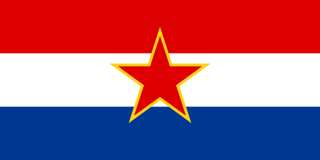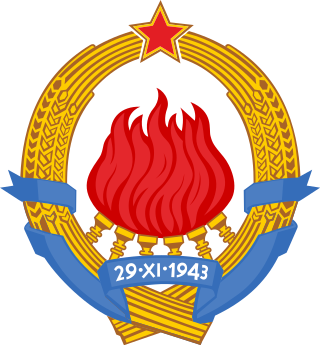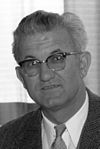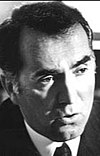The Anti-Fascist Council for the National Liberation of Yugoslavia, commonly abbreviated as the AVNOJ, was a deliberative and legislative body that was established in Bihać, Yugoslavia, in November 1942. It was established by Josip Broz Tito, the leader of the Yugoslav Partisans, an armed resistance movement led by the Communist Party of Yugoslavia to resist the Axis occupation of the country during World War II.

The President of Serbia and Montenegro was the head of state of Serbia and Montenegro. From its establishment in 1992 until 2003, when the country was reconstituted as a confederacy via constitutional reform, the head of state was known as the President of the Federal Republic of Yugoslavia. With the constitutional reforms of 2003 and the merging of the offices of head of government and head of state, the full title of the president was President of Serbia and Montenegro and Chairman of the Council of Ministers of Serbia and Montenegro. In 2006 the office was abolished as the state union was dissolved, with Serbia and Montenegro becoming independent countries and was followed by Kosovo in 2008 although it received limited international recognition.

The president of the Socialist Federal Republic of Yugoslavia was the head of state of that country from 14 January 1953 to 4 May 1980. Josip Broz Tito was the only person to occupy the office. Tito was also concurrently President of the League of Communists of Yugoslavia. Tito was eventually declared president for life and with his death in 1980 the office was discontinued and the new office of President of the Presidency of Yugoslavia took its place.

The Serbian Renewal Movement is a liberal and monarchist political party in Serbia. Since its formation in 1990, it has been led by writer Vuk Drašković.

The Socialist Republic of Croatia, commonly abbreviated as SR Croatia and referred to as simply Croatia, was a constituent republic and federated state of the Socialist Federal Republic of Yugoslavia. By its constitution, modern-day Croatia is its direct continuation.

The Socialist Republic of Bosnia and Herzegovina, commonly referred to as Socialist Bosnia or simply Bosnia, was one of the six constituent federal states forming the Socialist Federal Republic of Yugoslavia. It was a predecessor of the modern-day Bosnia and Herzegovina, existing between 1945 and 1992, under a number of different formal names, including Democratic Bosnia and Herzegovina (1943–1946) and People's Republic of Bosnia and Herzegovina (1946–1963).

The prime minister of Yugoslavia was the head of government of the Yugoslav state, from the creation of the Kingdom of Serbs, Croats and Slovenes in 1918 until the breakup of the Socialist Federal Republic of Yugoslavia in 1992.

The Socialist Republic of Serbia, previously known as the People's Republic of Serbia, commonly abbreviated as Republic of Serbia or simply Serbia, was one of the six constituent republics of the Socialist Federal Republic of Yugoslavia in what is now the modern day states of Serbia and the disputed territory of Kosovo. Its formation was initiated in 1941, and achieved in 1944–1946, when it was established as a federated republic within Yugoslavia. In that form, it lasted until the constitutional reforms from 1990 to 1992, when it was reconstituted, as the Republic of Serbia within the Federal Republic of Yugoslavia. It was the largest constituent republic of Yugoslavia, in terms of population and territory. Its capital, Belgrade, was also the federal capital of Yugoslavia.

The prime minister of Serbia and Montenegro was the head of government of Serbia and Montenegro from its establishment in 1992 up until the state's dissolution in 2006. Between 1992–2003 the full name of the office was President of the Federal Government of the Federal Republic of Yugoslavia, while after the constitutional reforms of 2003 the title was Chairman of the Council of Ministers of Serbia and Montenegro. The office was merged in 2003 with the head of state, providing for one person to hold both the office of President of Serbia and Montenegro and Chairman of the Council of Ministers of Serbia and Montenegro.

The office of the president of the Presidency of the Socialist Federal Republic of Yugoslavia existed from the death of the President of the Republic Josip Broz Tito on 4 May 1980 until the dissolution of the country by 1992.

The Order of the Yugoslav Star was the highest national order of merit awarded in Yugoslavia. It was divided into four classes. The highest class, the Yugoslav Great Star was the highest state decoration awarded in Yugoslavia. The order was mostly awarded to foreign heads of state for the development and strengthening of peace and cooperation between nations.

Elections were held on municipal, provincial, republican and federal levels in Yugoslavia from its foundation in 1918 throughout its breakup in 1992.

The Federal Executive Council was the executive body of the Socialist Federal Republic of Yugoslavia (SFRY) responsible for state affairs and for supervising the implementation of laws. It consisted of up to 15 members elected by the Federal Assembly for a four-year term and the presidents of executive councils of republics and provinces. The Federal Executive Council played an important role in the Government of the SFRY from its creation in 1953 until the breakup of Yugoslavia in 1992.

The office of vice president of the Socialist Federal Republic of Yugoslavia existed from April 1963 to June 1967. It was established by the new Yugoslav Constitution adopted on 7 April 1963. The first to serve in the role was Aleksandar Ranković who assumed office on 30 June 1963. Due to an affair involving wire-tapping of Yugoslav president and general secretary of the League of Communists Josip Broz Tito, Ranković was forced to resign from the Central Committee and from the vice presidency on 1 July 1966. He was subsequently replaced by Koča Popović two weeks later who served out the remainder of Ranković's four-year term. On 26 April 1967 new amendments to the 1963 constitution were approved which disestablished the vice presidency once Ranković and Popović's combined four-year term was up. The office ceased to exist on 30 June 1967.

The office of the vice president of the Presidency of the SFR Yugoslavia existed from the enactment of constitutional amendments establishing the position in 1971 until the dissolution of the country by 1992. A collective presidency existed in Yugoslavia since amendments to the constitution in 1971. The amendments established the roles of President and Vice President within the collective Presidency which would rotate between individual republics and provinces on an annual basis. However, it also defined a separate title of President of the Republic which could be conferred by the Federal Assembly into Josip Broz Tito who would automatically preside over the Presidency as well. Therefore, the launch of the Vice Presidency of the Presidency in 1971 would be the first to carry out a rotation system. Krste Crvenkovski of SR Macedonia was the first to hold the office. The subsequent order after SR Macedonia was SR Bosnia and Herzegovina, SR Slovenia, SR Serbia, SR Croatia, SR Montenegro, SAP Vojvodina, and SAP Kosovo. In 1974 a new Constitution was adopted which reaffirmed the collective federal presidency consisting of representatives of the six republics, the two autonomous provinces within Serbia and the President of the League of Communists.

The office of the president of the presidency of the Socialist Republic of Serbia existed from its establishment in the 1974 constitution to its renaming and then total abolishment as part of democratic reforms in 1990.

The Government Building, formally the Government of the Republic of Serbia Building is the seat of the Government of Serbia. It houses the office of the Prime Minister as well as the Secretariat-General of the Government, and serves as a meeting place of cabinet of ministers. It is located in Savski Venac, Belgrade, Serbia.
The Socialist Republic of Croatia, one of the constituent countries of the Socialist Federal Republic of Yugoslavia had gone through a number of phases in its political life, during which its major political characteristics changed - its name, its top level leadership and ultimately its political organization.






















